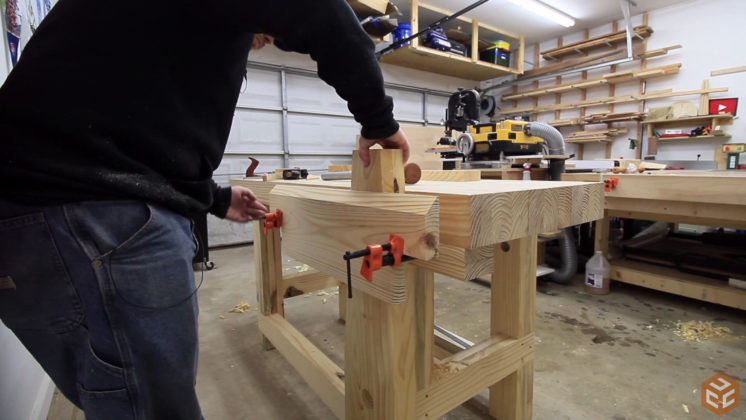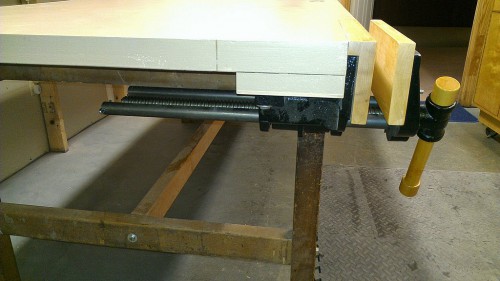
- Choose Where to Put your Vise. A vise will usually be best situated near a corner as many other places will either be in the way, or will be ...
- Position the Vise. If you are installing a bench top vise, place the vise in position and mark where the holes will be.
- Bolt on the Filler Block. Install the filler block for the vise. ...
- Mount the Vise. Position the vise on the block with the back jaw against the edge of the bench. Drill the pilot holes and add the lag screws.
- Put the Vise Back Together Again. If you took apart the vise while mounting it, put it together again now.
How to install a woodworking bench vise?
- Things to know:
- You have to space the vise and dogholes around the bench legs and any facevise mounting hardware.
- You also can hold stock vertically between the movable jaw and the bench.
- A quick release, available on some tail vises, speeds up big changes in vise position. ...
How to build a workbench simple DIY woodworking project?
How to Build your own DIY Workbench
- DIY Workbench Tools Needed. Orbital Sander– Ryobi makes a nice one.
- DIY Workbench Supplies Needed. This simple DIY Workbench can be made for about $175 in materials cost. ...
- Cut All of the Wood Pieces. ...
- Start Assembly, Making the Top First. ...
- Assemble the Bottom. ...
- Cut the Plywood and Attach. ...
- Stain and Finish the Workbench. ...
- Get to Work! ...
How to design and build the perfect Workbench?
- You need 4 - 4 foot lengths of 2x4s
- Set up the sled so that it cuts between a 1/16 and 1/8 of an inch more than 3 1/2 inches
- Measure the height of the mortise (2.436 inches)
- Measure the height of the 2x4 (3.481 inches)
- Subtract the smaller from the larger and divide by two (0.5225 inches)
How to make a wood vise?
Make a Bench Vise for Woodworking
- What You Need. About 16 linear feet of one by six hardwood (actual measurements ¾” x 5½”). ...
- Front Jaw. Cut two 32” long pieces from the one by six board. ...
- Rear Jaw. The rear jaw is L-shaped. ...
- Drill Holes for the Hex Bolts. Drill two ½” holes through the front jaw 3” from the short edge and 2 ¼” from the top edge. ...
- Make Handles. ...
- Use Your Bench Vise. ...
See 7 key topics from this page & related content

How do you mount a workbench vise?
8:069:11How to Mount a Workbench Vise - YouTubeYouTubeStart of suggested clipEnd of suggested clipWith four countersunk screws to the side edge of the bench top itself. I'm doing that here justMoreWith four countersunk screws to the side edge of the bench top itself. I'm doing that here just using some nice long number ten production screws.
Where should a vice be placed on a workbench?
0:5211:36How to Install a Bench Vise - YouTubeYouTubeStart of suggested clipEnd of suggested clipSo I personally like it in the corner of your other workbench whenever possible and as close as youMoreSo I personally like it in the corner of your other workbench whenever possible and as close as you can get it to the edge on both sides here and equal.
How do you install a wood working vice?
2:064:38How to install a Woodworking Vise// Woodworking// Quick Release ViseYouTubeStart of suggested clipEnd of suggested clipThen install the screws that will mount the front of the vise to the front jaw take quick-releaseMoreThen install the screws that will mount the front of the vise to the front jaw take quick-release vise you just barely want to put the screws in the guide rods in place so that you can situate.
What is normal workbench height?
34″ – 36″34″ – 36″ (86cm – 91cm) tend to be the most common workbench height for woodworking. A height in between these two extremes tends to be the most popular, particular if you do a range of activities at your workbench.
What clamping position should be considered when mounting a vise on a workbench?
What clamping position should be considered when mounting a vise on a workbench? The vise should be positioned so that a long piece can be held vertically in the jaws without interference from the workbench.
How do you fix a vice to a bench?
0:252:11How to Fix a Vice on a Workbench | Woodworking - YouTubeYouTubeStart of suggested clipEnd of suggested clipMake sure the handle is jutting out that you can loosen and tighten the vise easily mark the spotMoreMake sure the handle is jutting out that you can loosen and tighten the vise easily mark the spot where you will drill a hole using a pencil. Use a center punch to make the pilot holes.
What can I use instead of a vice?
Synonyms & Antonyms of vicecorruption,debauchery,depravity,immorality,iniquitousness,iniquity,libertinage,libertinism,More items...
How do you hang a vise without a bench?
2:096:17Mounting a vise without taking up bench space. - YouTubeYouTubeStart of suggested clipEnd of suggested clipSo you just go to the spot that it's at. And the holes are just a little bit loose so that they don'MoreSo you just go to the spot that it's at. And the holes are just a little bit loose so that they don't bind up.
Can you reinforce dado joints?
Allow the glue to cure. You could reinforce this dado joint with screws or dowels if you want, but with this much contact and the dimensional strength of the plywood, I think it'll stand up to any force I can apply with my hands. Also, at this point, I wiped on a coat of Danish Oil.
How long does it take to attach a bench dog to a bench?
This might be useful in the future if I'm cutting something quite long and need the side-to-side clearance and support in the middle. This took about 6 seconds.
What to do if you don't have a table saw?
If you don't have a table saw, you can do this with a circular saw or even a handsaw. Just make sure to mark a baseline, and keep everything secure.
Do I need to clean my Douglas fir blade?
Yes, I know I need to clean my blade. I've been cutting a lot of relatively fresh Douglas fir for a project, and the pitch has left a lot of build-up. I'll be following this tutorial soon!
Can you take a vise off?
Now that you have your measurement and the jaw (s) cut, you can take the vise off.
Can you add an outer jaw to a vise?
So on my vise i chose to only add an outer jaw, and use the edge of the benchtop for my inner jaw but you can do this a couple different ways so do what works best for you! Cut the oversized jaw to length and width, but dont forget to leave a little extra so you can dial it in later.
Can you remove the quick release nut?
Remove quick release nut, but REMEMBER how it goes, i suggest taking a picture of it's oreintation so that you make sure it goes back correctly, if not the vise will not operate as intended.
Crosscut Sled for Large Panels
Steve Fikar's panel sled is guided by a single runner in one miter slot attached to a torsion-box base to keep the sled light.
Shop Talk Live Podcast
Our biweekly podcast allows editors, authors, and special guests to answer your woodworking questions and connect with the online woodworking community.
